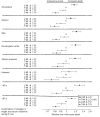The obesity paradox and mortality associated with surrogates of body size and muscle mass in patients receiving hemodialysis
- PMID: 21037042
- PMCID: PMC2966362
- DOI: 10.4065/mcp.2010.0336
The obesity paradox and mortality associated with surrogates of body size and muscle mass in patients receiving hemodialysis
Abstract
Objective: To determine whether dry weight gain accompanied by an increase in muscle mass is associated with a survival benefit in patients receiving maintenance hemodialysis (HD).
Patients and methods: In a nationally representative 5-year cohort of 121,762 patients receiving HD 3 times weekly from July 1, 2001, through June 30, 2006, we examined whether body mass index (BMI) (calculated using 3-month averaged post-HD dry weight) and 3-month averaged serum creatinine levels (a likely surrogate of muscle mass) and their changes over time were predictive of mortality risk.
Results: In the cohort, higher BMI (up to 45) and higher serum creatinine concentration were incrementally and independently associated with greater survival, even after extensive multivariate adjustment for available surrogates of nutritional status and inflammation. Dry weight loss or gain over time exhibited a graded association with higher rates of mortality or survival, respectively, as did changes in serum creatinine level over time. Among the 50,831 patients who survived the first 6 months and who had available data for changes in weight and creatinine level, those who lost weight but had an increased serum creatinine level had a greater survival rate than those who gained weight but had a decreased creatinine level. These associations appeared consistent across different demographic groups of patients receiving HD.
Conclusion: In patients receiving long-term HD, larger body size with more muscle mass appears associated with a higher survival rate. A discordant muscle gain with weight loss over time may confer more survival benefit than weight gain while losing muscle. Controlled trials of muscle-gaining interventions in patients receiving HD are warranted.
Figures





References
-
- United States Renal Data System USRDS 2006 Annual Data Report: Atlas of End-Stage Renal Disease in the United States. In: National Institutes of Health NIoDaDaKD , ed. USRDS Annual Report. Bethesda, MD: NIH/NIDDK; 2008. http://www.usrds.org/atlas_2006.htm Accessed August 6, 2010
-
- Chertow GM, Hsu CY, Johansen KL. The enlarging body of evidence: obesity and chronic kidney disease. J Am Soc Nephrol. 2006;17:1501-1502 - PubMed
-
- Lavie CJ, Milani RV, Ventura HO. Obesity and cardiovascular disease: risk factor, paradox, and impact of weight loss. J Am Coll Cardiol. 2009;53:1925-1932 - PubMed
-
- Lavie CJ, Milani RV, Artham SM, Patel DA, Ventura HO. The obesity paradox, weight loss, and coronary disease. Am J Med. 2009;122:1106-1114 - PubMed

